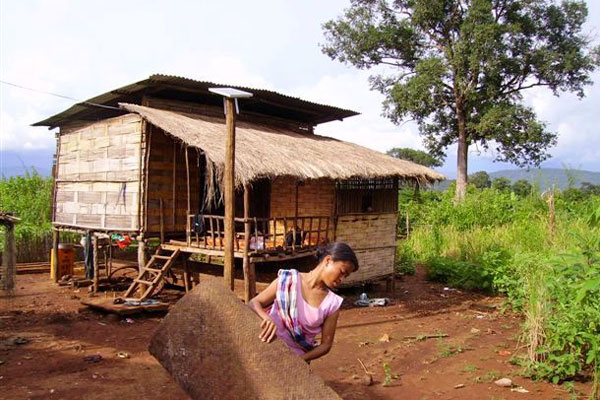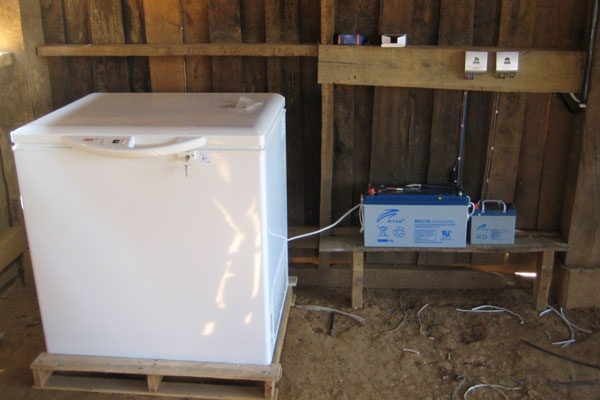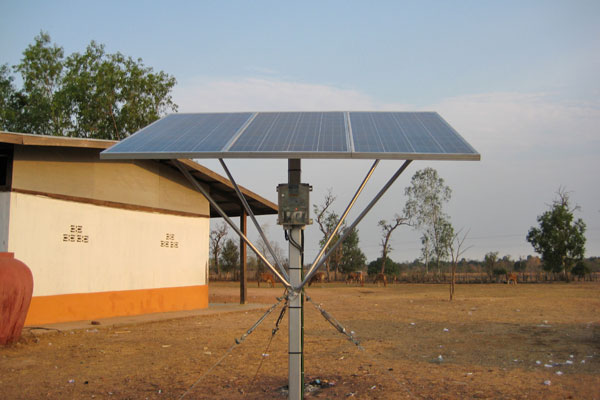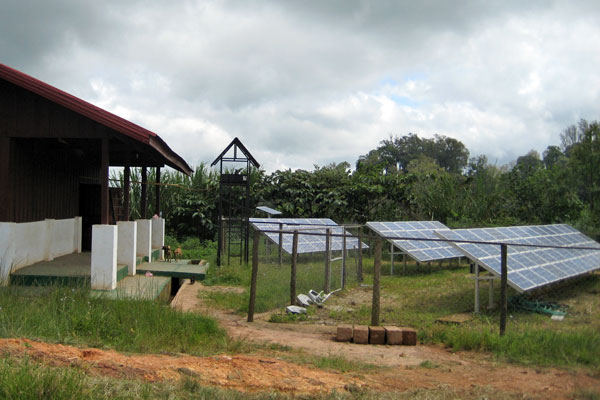What We Do
Sunlabob provides full-spectrum support for renewable energy projects, from “soft” consultancy, design, training and monitoring services to “hard” supply, installation and maintenance.
We’re experienced in on and off-grid electrification, from grid-tied solar rooftops to solar farms and solar-lanterns to decentralised mini-grids, including water pumps, vaccine fridges and many other renewable energy applications.
Common to all these activities is our trademark engagement with community stakeholders, commitment to quality components and encouraging sustainability through entrepreneurship.
Whether yours is a stand-alone project inspired by an individual, a business or an on-going programme run by a Development Agency, NGO or Government, we can help with;
- Feasibility studies
- Business models and plans
- System design
- O&M planning
- Training
- Project management
- Project monitoring and appraisal
- Hardware supply
- Installation and commissioning
- User training
- Maintenance
How it works
Click on the tabs below to read more about some of the systems we specialise in.
- Solar Energy Systems: Grid Connected
- Solar Energy Systems: Off Grid – Solar Home System
- Solar Pico Lanterns
- Solar Cooling with Solar Fridge
- Solar Water Pump Systems
- Hybrid Village Grids
- Solar Village Grid
- Backup Systems
What is it

In a Grid Connected Solar System, solar energy, which is linked to a feed-in grid system, supplies an entire building with electricity and reduces the customer’s energy costs. Moreover, surplus electricity generated is fed into the national grid, allowing the owner of the Solar Feed-in System to sell the access electricity to the national utility provider.
Not only does the Grid Connected Solar System produce its own energy and feeds in energy surplus into the collective grid, it also improves the effectiveness of the customer’s operations through an optional extensive battery back-up system. Should power cuts occur, the customer will still be able to operate all their electrical appliances.
How it works

During the day, solar electricity supplies any power requirements of the home / building with any shortage drawn in from the grid. If the solar array produces more power than what the home / building needs, then the excess solar electricity is fed out through the switchboard into the grid, running the meter backwards. At night when there is no solar power being produced, electricity is drawn in from the grid.
The end user does not need to do anything to make the system work and will notice no change at all in the way their electricity operates. The only difference is some panels on the roof, an inverter next to the switchboard and a reduced electricity bill.
Applications
For homes, offices, industrial buildings etc.
What is it

Solar Home Systems (SHS) are small to mid-size systems using photovoltaic solar energy and battery storage to provide electricity where there is no access to the grid. Solar energy is harnessed through photovoltaic panels installed nearby the house or building and is connected to a battery bank. During night hours, the battery bank supplies the electricity to specific appliances. Such systems are individually sized to suit the end users’ needs and can be used for households, offices or business entities that are scattered throughout different areas or entire villages.
How it works
A Solar Home System consists of the following components:
- Solar panels that deliver electricity from the sun
- A battery set that stores the electricity produced by the solar panel and can deliver it at any time of the day
- A charge controller that protects the battery from overcharging
A Solar Home System works all year round, without the need for any other power source. The battery bank is designed to have at least 5 days autonomy, which means that even if there are five consecutive very cloudy days, the system is still able to work. We offer a variety of sizes from 20 W to 150 W and higher.
During night hours, the battery bank supplies the electricity to specific appliances. Such systems are individually sized to suit the end users’ needs and can be used for households, offices or business entities that are scattered throughout different areas or entire villages.
Applications
Solar Energy Systems have various applications, such as in household application to power lights and electrical appliances. They can also be used to power health stations located in villages, schools, small businesses, etc.
What is it

The Pico Lanterns is a multifunctional mobile or stationary lighting device that has been specially designed to meet the needs of rural households and commonly include a USB port and charging socket for charging/running external mobile devices.
How it works
Pico Lanterns contain a battery and a internal charge controller, which manages the system. They can be charged with a solar panel.
Applications
Lighting for villagers in remote areas not connected to the electrical grid (for school, reading, income-generating activities such as weaving, sewing, handicraft making, night time social activities, etc).
For charging/running external mobile devices
What is it

By harnessing solar energy, Solar Cooling Systems are able to keep much needed vaccines at their appropriate temperature to avoid spoilage. Vaccines are the most cost-effective healthcare intervention. Yet, they are still largely unavailable in developing countries. They are difficult to transport because they lose their effectiveness if not kept within certain temperatures. As such, health posts struggle to effectively vaccinate the remote and sparse populations. These systems are perfect for areas of the developing world where electricity is unreliable or non-existent.
How it works
A standard fridge and freezer runs on AC Voltage and needs approximately 1200 Wh of energy/day. To run such a device with solar power, you will need a strong AC inverter, about 450 Wp of solar panels and a battery set with 500 Ah. Thus, it is not economical to run a standard fridge/freezer with solar energy.
Solar fridges and freezers on the other hand run on DC voltage (12/24 V) with a brushless compressor. No inverter is needed, and the refrigerator consumes only 150 Wh of energy per day. The required solar system is small, comprising of a 70 Wp solar panel and a 70Ah battery. On the whole, the solar fridge and freezer minimises the customer’s total system cost.
Applications
Apart from health posts, the solar fridge system is also ideal for eco-resorts, home use and commercial use of cooling or freezing service like: markets, stores, beverage vending, ice making.
What is it

For people living in remote areas, solar water pumps are an excellent alternative to costly and polluting diesel pumps.
A solar powered water pump differs from a regular water pump only in that it uses the sun’s energy to supply electricity for the pump. The solar panels absorb the sun’s energy and convert it to electrical energy for the pump to operate. All the pumped water is stored in a water tank so that there is constant supply even in bad weather conditions and during night time where there is insufficient power to generate the solar water pumps. Solar powered water pumps represent a higher initial investment, however, over a period of 5 years they represent a cost benefit due to minimal maintenance costs compared to AC pumps run with a generator.
How it works
A Solar Water Pump System comprises several PV (photovoltaic) panels that produce direct current (DC) electricity when exposed to sunlight. The DC current is collected by the wiring in the panel. The current is used to supply a DC pump, which pumps water whenever the sun shines, or the current is stored in batteries (for a battery-coupled pumping system) for later use by the pump.
Applications
Solar water pumps are being used throughout the world for a number of different applications, such as for homesteads, livestock watering, crop irrigation etc.
What is it
Village Hybrid Grids (VHG) can be installed in villages of any size. Villages with a VHG are not connected to the main electrical network or “grid”, thus prior to the installation of a VHG they have no access to electricity. Multiple sources of energy (these can include, solar, hydro, batteries, generator or wind) supply the electricity requirements of the village. The different sources of energy are strategically designed to accommodate the fluctuating loads of the village throughout the day and night. VHGs are typically the best renewable energy option when it comes to providing energy 24 hours a day.
How it works
A hybrid system combines solar, hydro, batteries, generator and wind resources and feeds them into the same village grid. The HVG utilises solar energy, which is always available during the day, and generators as back-up systems when water flow levels are low at different points of the year. This combination helps to go beyond improving living conditions and moves towards increasing income for households.
The electrification from local hybrid grids enables households and local industries to satisfy their daily energy needs.
Application
VHGs are primarily installed in villages, hybrid grids can be installed at resorts/lodges, hospitals, farming estates, large workshops/factories.
What is it

Solar Village Grids are supported by battery backup and sometimes generators. During the day, the solar panels produce electricity which feeds the immediate electrical needs of the village and re-charges the battery bank. At night the batteries supply the electrical demand of the village. The systems are customized to meet the load of the village therefore making every village grid system slightly different. Electrical needs are covered by power from the batteries on days without sunshine.
How it works
A solar village grid can provide basic electrical needs to a whole community of 50-1,000 households. Each household can be provided with efficient room lighting and have power points to run small electrical items such as radios, CD players, phone chargers, small TVs or netbook computers. It can also be used to power lighting and entertainment equipment in a village community centre or for a refrigerator in a village health station.
Application
For communities in off-grid areas.
What is it
When the mains power cuts off, a Backup System continues providing electricity without interruption (from 1 hour up to 4 days). Consisting of batteries and electrical devices, the Backup System is suitable for customers who need a constant power supply to run a business, to run sensitive devices (e.g. hospital equipment) and protect IT hardware and software from immediate power cuts. Diesel generators are noisy and often inefficient and unreliable. Backup Systems perfectly fill the gap and secures constant power supply during unforeseen power cuts.
How it works
The Inverter consists of a sine wave inverter with a high overload capacity, a battery charger and a transfer system.
The in-built multifunctional contact allows you to start a diesel generator to recharge batteries or to cut the power for less priority loads when the battery is lower than a given threshold.
The integrated power sharing function ensures that the transfer system always provides the connected loads with the desired power.
Application
The backup system can be used to support solar grid connected systems so the loads will still be powered even if the public electricity grid fails. The backup system can also be used in buildings, such as offices and hospitals, to ensure that there is still power in case the public electricity grid fails.
